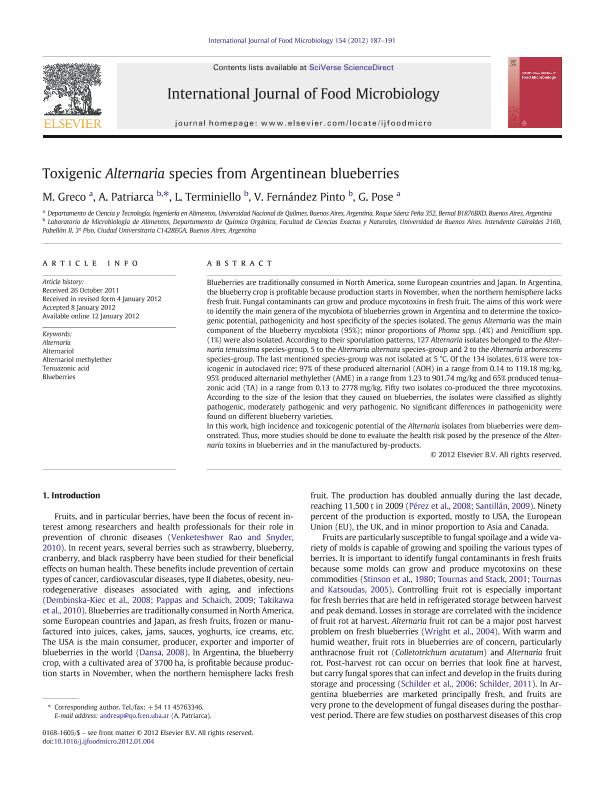Mostrar el registro sencillo del ítem
dc.contributor.author
Greco, Mariana Vanesa

dc.contributor.author
Patriarca, A.
dc.contributor.author
Terminiello, Laura Adriana

dc.contributor.author
Fernández Pinto, Virginia Elena

dc.contributor.author
Pose, Graciela Noemi

dc.date.available
2023-04-19T17:18:01Z
dc.date.issued
2012-01
dc.identifier.citation
Greco, Mariana Vanesa; Patriarca, A.; Terminiello, Laura Adriana; Fernández Pinto, Virginia Elena; Pose, Graciela Noemi; Toxigenic Alternaria species from Argentinean blueberries; Elsevier Science; International Journal of Food Microbiology; 154; 3; 1-2012; 187-191
dc.identifier.issn
0168-1605
dc.identifier.uri
http://hdl.handle.net/11336/194576
dc.description.abstract
Blueberries are traditionally consumed in North America, some European countries and Japan. In Argentina, the blueberry crop is profitable because production starts in November, when the northern hemisphere lacks fresh fruit. Fungal contaminants can grow and produce mycotoxins in fresh fruit. The aims of this work were to identify the main genera of the mycobiota of blueberries grown in Argentina and to determine the toxicogenic potential, pathogenicity and host specificity of the species isolated. The genus Alternaria was the main component of the blueberry mycobiota (95%); minor proportions of Phoma spp. (4%) and Penicillium spp. (1%) were also isolated. According to their sporulation patterns, 127 Alternaria isolates belonged to the Alternaria tenuissima species-group, 5 to the Alternaria alternata species-group and 2 to the Alternaria arborescens species-group. The last mentioned species-group was not isolated at 5. °C. Of the 134 isolates, 61% were toxicogenic in autoclaved rice; 97% of these produced alternariol (AOH) in a range from 0.14 to 119.18. mg/kg, 95% produced alternariol methylether (AME) in a range from 1.23 to 901.74. mg/kg and 65% produced tenuazonic acid (TA) in a range from 0.13 to 2778. mg/kg. Fifty two isolates co-produced the three mycotoxins. According to the size of the lesion that they caused on blueberries, the isolates were classified as slightly pathogenic, moderately pathogenic and very pathogenic. No significant differences in pathogenicity were found on different blueberry varieties.In this work, high incidence and toxicogenic potential of the Alternaria isolates from blueberries were demonstrated. Thus, more studies should be done to evaluate the health risk posed by the presence of the Alternaria toxins in blueberries and in the manufactured by-products.
dc.format
application/pdf
dc.language.iso
eng
dc.publisher
Elsevier Science

dc.rights
info:eu-repo/semantics/openAccess
dc.rights.uri
https://creativecommons.org/licenses/by-nc-sa/2.5/ar/
dc.subject
ALTERNARIA
dc.subject
ALTERNARIOL
dc.subject
ALTERNARIOL METHYLETHER
dc.subject
BLUEBERRIES
dc.subject
TENUAZONIC ACID
dc.subject.classification
Micología

dc.subject.classification
Ciencias Biológicas

dc.subject.classification
CIENCIAS NATURALES Y EXACTAS

dc.title
Toxigenic Alternaria species from Argentinean blueberries
dc.type
info:eu-repo/semantics/article
dc.type
info:ar-repo/semantics/artículo
dc.type
info:eu-repo/semantics/publishedVersion
dc.date.updated
2023-04-18T13:12:12Z
dc.journal.volume
154
dc.journal.number
3
dc.journal.pagination
187-191
dc.journal.pais
Países Bajos

dc.journal.ciudad
Amsterdam
dc.description.fil
Fil: Greco, Mariana Vanesa. Consejo Nacional de Investigaciones Científicas y Técnicas; Argentina. Universidad Nacional de Quilmes. Departamento de Ciencia y Tecnología. Área Ingeniería en Alimentos; Argentina
dc.description.fil
Fil: Patriarca, A.. Universidad Nacional de Quilmes. Departamento de Ciencia y Tecnologia. Area Ingenieria en Alimentos. Laboratorio de Microbiologia de Alimentos; Argentina
dc.description.fil
Fil: Terminiello, Laura Adriana. Universidad Nacional de Quilmes. Departamento de Ciencia y Tecnologia. Area Ingenieria en Alimentos. Laboratorio de Microbiologia de Alimentos; Argentina. Consejo Nacional de Investigaciones Científicas y Técnicas; Argentina
dc.description.fil
Fil: Fernández Pinto, Virginia Elena. Universidad Nacional de Quilmes. Departamento de Ciencia y Tecnologia. Area Ingenieria en Alimentos. Laboratorio de Microbiologia de Alimentos; Argentina. Consejo Nacional de Investigaciones Científicas y Técnicas; Argentina
dc.description.fil
Fil: Pose, Graciela Noemi. Consejo Nacional de Investigaciones Científicas y Técnicas; Argentina. Universidad Nacional de Quilmes. Departamento de Ciencia y Tecnología. Área Ingeniería en Alimentos; Argentina
dc.journal.title
International Journal of Food Microbiology

dc.relation.alternativeid
info:eu-repo/semantics/altIdentifier/url/http://www.sciencedirect.com/science/article/pii/S0168160512000074
dc.relation.alternativeid
info:eu-repo/semantics/altIdentifier/doi/http://dx.doi.org/10.1016/j.ijfoodmicro.2012.01.004
Archivos asociados
